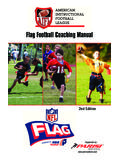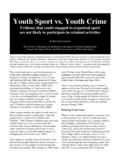Transcription of NFL Flag Football Formations - Youngstown Youth Flag ...
1 flag Football Playbook & Formations In the we work with the understanding that there are three basic formation calls: Split T, Twins and Tri ps. Variati ons and adjustments to the formati on may be made. In our fi rst series of pl ays we run ou t of the most basic formation , the Split T, where one recei ver is on ei ther side of the bal l, split out approximately 10-12 yards from the center, with a sing le running bac k set behi nd the quarterbac k. Thi s is a bal an ced format ion in NFL FL AG wi th no strong si de, therefore we will not have a call side (no right or left). The formation when set loo ks li ke the letter "T. The first ca ll made when setting a play will be the formation .
2 In thi s di agram, three receivers go to the call si de of the formation . Thi s is a no ba ck formation . In this diagram, two receivers go to the call side of the formation . There is the option to have a single back or no backs. **Coaching Tip** Whether you are an experienced coach or a novice taking the reins of your first team, your main goal should be to create a fun and safe learning environment for your players. Many of the skills your players will practice and play with are just like those of their NFL heroes. Feel free to emphasize this connection to the real-life game! flag Plays-Passing Tree . Passing Tree Routes / Number Slant 2 Drag / In 4 Curl 6 Post 8 Quick Out- 1 Deep Out- 3 flag 5 Post Corner 7 Fly 9 The Passing Tree is a numbered system used for the passing routes.
3 The passing tree system is designed so that all even-numbered routes (2,4,6,8) are run towards the middle of the field and all odd-numbered routes (1,3,5,7,9) are be run towards the sideline. These routes are used for all positions on the field. The running back has extra routes that are always be referred to by name. Since the ball is always placed in the middle of the field, the center faces the dilemma, and all of the center s routes should be based on the play design. flag Plays-Passing Tree Receiver Route Definitions Quick Out (1): This is a 5-8 yard route forward then the receiver cuts out towards the sideline then looks for the ball. Slant (2):This is a 3-5 yard route forward then the receiver breaks towards the middle of the filed on a 45 degree angle and looks for the ball.
4 Deep Out (3): This is a 10-15 yard route. It should be run exactly like the quick out only deeper. This is a 5-8 yard route forward then the receiver breaks into the middle of the filed on a 90 degree angle and looks for the ball. Drag/In (4): flag (5): This is a 10-15 yard route forward then the receiver breaks at a 45 degree angle towards the sideline and looks for the ball. Curl (6): This is a 5-8 yard route forward then the receiver stops and turns to the ball. Post Corner (7): This is a 12-20 yard route forward then the receiver cuts on a 45 degree angle to the middle of the field for a few steps then the receiver cuts on a 45 degree angle towards the sideline and then looks for the ball. Post (8): This is a 12-20 yard route forward then the receiver breaks on a 45 degree angle towards the middle of the field and looks for the ball.
5 Fly (9): This route is run straight up the field with the receiver looking for the ball after he gets past about 15 yards. * For younger participants the passing routes can be reduced by half flag Plays-Passing Tree Running Back Routes While your backs may run any of the assigned routes on the primary passing tree, these routes have been designed as a high-percentage second option to complete a pass. **These routes will not be numbered. You will always refer to them by name.** flag Plays-Passing Tree Running Back Route Definitions ReplaceThis is a 8-15 yard route where the running back angles forward on a 45 degree angle and then goes straight up the field and looks for the ball. Arrow This route the running back drives on a 45 degree angle towards the sideline and looks back for the ball.
6 Circle This route starts toward the sideline and then circles back to in front of the QB. This route starts straight up the field then the running back breaks "out" or "in" depending on the play. Out/In * For younger participants the passing routes can be reduced by half flag Plays-Passing Tree Secondary Routes Replace Exactly what the route is called. Your secondary or safety receiver should drive to and replace the area where your receivers were aligned. Works well in the case when receivers clear out one side of the field. **Coaching Tip** Let Them Play Football !!! The temptation to be another Don Shula or Bill Walsh will have to wait. This is NFL flag . While teaching Football skills and strategies is important, keep your lessons as simple as possible.
7 As your team grasps the basics, move on to more advanced ideas. Overloading young players with too much information too early can cause confusion for them and headaches for you. A route in which the receiver drives on a 45 degree angle, always toward the side line. The receiver should always look over the outside shoulder for the pass. Arrow Stop Look for open space. Turn to the quarterback with your back to the defender. This should be a pass to the chest. Circle / Wheel The wheel route is an extension of the arrow. If the quarterback does not throw the ball to the arrow route, the receiver will turn and run up the sideline for an extened route. Rounded off pattern in the backfield with the completion coming near or at the line of scrimmage.
8 Usually executed by a running back being used as a second or third option. A pass option for a quarterback when his main options have been shut down Flare flag Plays-How to Call a Play Now that you've read your passing tree and understand the pass routes available, there are two options you have in play calling. The simple option is to use positions attached to route names. The more advanced option is to use the passing tree numeric system. There will be a few constants when calling plays. 1. You will always call the formation first, including the alignment (left or right, if necessary). You ll call an alignment in an unbalanced formation (anything but a Split T. See examples below). 2. You will always call your receiver pass routes from left to right (then your Halfback (H) route, followed by the Center route) Position Key Q - Quarterback L Left Receiver M Middle Receiver R Right Receiver RB Running Back C Center Three receivers go to the call side of the formation This is a no back formation Two receivers go to the call side of the formation There is the option to have a single back or no backs.
9 **Coaching Tip** Sportsmanship Rules!! Help your players be good sports. After a game, shake hands with or do a cheer for the other team. Applaud good play by both sides. Treat officials with respect. While imitating you, your team won't even recognize the good lesson they re learning. flag Plays-Plays Examples Based on the passing tree routes, and using our formula of calling your receiver routes from left to right followed by the running back route then the center route, the following play would be called: Split T Left Fly Right Fly H Flare Left Center Stop If we stick with our formula, the same play in a different formation will look like this: Twins Right Single Back Left Fly Right Fly H Flare Left Center Stop **Coaching Tip** Tackle Tackling Early!
10 !! Don't let your practices dissolve into a giant pile of rambunctious kids. For both their safety and your sanity, make sure to discourage any tackling or roughness early on. Remind them that they won't help their team in a game by tackling or being rough. flag Plays-Plays Examples If we move to a three receiver set with no running back, (a Trips formation or Twins with a single receiver split opposite the call side), we now have a middle, or M receiver. Our play call formula remains the same the play call is your receivers from left to right followed by the center call (since there is no running back in these Formations there are no running back calls). Trips Right Left Fly Middle Fly Right Fly Center Arrow If we stick with our formula, the same play in a different formation will look like this.







